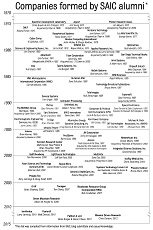The Cybersecurity Challenge: Corporate Cybercrime and Government Cybercrime
6 Comments Published by Dr. Beyster July 28th, 2009 in Network Solutions.As I mentioned in the first of three installments on the Cybersecurity Challenge, there are two broad areas of cybercrime to consider: corporate cybercrime and government cybercrime. In this installment of the article, I will address each one of these threats in turn.
Corporate Cybercrime
We know from published statistics that corporate cybercrime has become a very significant issue all across the world, from people stealing credit card and phone cards and using them across the globe, all the way to breaking into very proprietary, sensitive business and personal information that’s held in large databanks in corporations all over the world. While it’s likely that U.S.-based corporations have a better track record of defending against cybercrime than those in other countries, the picture is very sketchy because most corporations are reluctant to even report this unless it’s something particularly major, where they believe they need to contact law enforcement.
Based on the statistics published by the major credit card companies alone — the Visas and MasterCards of the world — corporate cybercrime is a multi-million-dollar problem — probably hundreds of millions of dollars, if not more — and people are hacking into the corporate systems regularly, whether it be credit card companies, large banks, travel companies, the Procters and Gambles of the world, or medical healthcare records. Within the United States, from January 1, 2008 to December 31, 2008, the FBI’s Internet Crime Complaint Center (IC3) website received 275,284 complaint submissions. This is an increase of 33.1 percent over 2007, when 206,884 complaints were received. According to the FBI’s data, these filings were composed of complaints primarily related to fraudulent and non-fraudulent issues on the Internet.
The complaints registered by the IC3 website comprised many different fraud types such as auction fraud, non-delivery, and credit/debit card fraud as well as non-fraudulent complaints such as computer intrusions, spam/unsolicited e-mail, and child pornography. All of these complaints have been made accessible to federal, state, and local law enforcement to support active investigations, trend analysis, and public outreach and awareness efforts.
From the submissions received via its website, IC3 referred 72,940 complaints of crime to federal, state, and local law enforcement agencies around the country for further consideration. The majority of reported cases involved fraud and a financial loss on the part of the complainant. The total dollar loss from all referred cases of fraud was $264.6 million with a median dollar loss of $931.00 per complaint. According to IC3 figures, this is up from $239.1 million in total reported losses in 2007.
There’s good reason to believe that this is just a small fraction of the sum of corporate cybercrime within the United States in 2008.
Of particular concern are two specific Internet security issues: DNS hijacking and routing security. DNS can be hijacked — you go to eBay at ebay.com, but you actually end up at a spoof site. Or you’re trying to go to your bank and end up at a bank that’s actually an impostor specifically designed to capture your login information — user name and password. A newer threat is the hijacking of routing information underneath it so that you could have legitimate set of IP addresses going through a third party — either to eavesdrop or to host content that could look exactly the way it was supposed to.
Beyond the taking of customer information, hackers are stealing company-proprietary information — including designs, business plans, intellectual property, and financial and budgeting information — and selling it to the highest bidder. People in every major corporation and even smaller companies — from the CIOs of companies to the security guys — are very concerned about this issue and are spending a lot of time and effort trying to figure out how to fight the attacks and defend their websites and computer networks. And it’s a good thing they are — there are countless documented cases where company websites have been shut down or diverted, and huge quantities of data taken.
Government Cybercrime
At the government level, there is cybercrime of both the state-sponsored and non-state-sponsored cybercrime varieties. Of particular note is the relatively quick evolution of the cyberprotection initiative under the Bush administration. From what’s been published, it’s apparent that the United States government has spent many billions of dollars during the course of the Bush administration trying to thwart such attacks, including consolidating networks so there are fewer ways for people to get into federal agency computer networks.
And there is great reason to be concerned.
A recent Business Week article documented how cybercriminals had hacked into NASA’s “super-secure” Kennedy Space Center computers in April 2005 and used a malignant software program by the name of stame.exe data to gather about 30 million pages worth of data about the Space Shuttle. This data was then shipped off to Taiwan by the software program, where it presumably was then forwarded to China. There have been endless, repeated, ongoing attacks on the Department of Defense and key databases all through most of the military services. Again, all of this has been publicly made known in the press. However, much remains unreported due to its sensitivity.
Most of the civilian agencies in the United States did little or nothing about cybercrime until four or five years ago. Now they see that everything from Social Security data, medical healthcare records, defense data, and so on has been penetrated or there are repeated attempts to penetrate their databases. So the United States government is today very serious about it — or at least they tell us they are.
State-sponsored cyberterrorism is a subcategory of the government cybercrime business and there are documented situations where actual state-sponsored groups are active, especially out of China and Russia. We certainly know that this was the case with Russia and Georgia recently but China, it appears, has been one of the most active sources of what is being called state-sponsored cybercrime. These are attempts to penetrate databases all over the world — not just the United States — that have defense, intelligence, and personal data. It’s the just next kind of a level that we’ve all worried about for years of espionage, of getting everything from munitions designs to airplane designs to rocket designs, etc. It’s taken, if you will, into the cyberworld.
The Department of Homeland Security (DHS) is a place where the Bush administration has placed a lot of responsibility for guarding the government against cybercrime. Clearly, the Department of Defense has its own capability (witness the recent announcement of the creation of the U.S. Cyber Command, which will be tasked to defend DoD cyberspace under STRATCOM), as does the intelligence community. However, the place where the cyberinitiatives and counter cyberterrorism have been built up on the civilian side of the government is DHS. My understanding is that Barack Obama is very close to selecting a chief technology officer — a technology czar of sorts — to try to coordinate a lot of technology initiatives at the White House level. There’s been discussion that that person would even be a cabinet officer which is significant. Our country has never had anything like that in any previous administration, but the growing threat seems to merit this high level of attention going forward.
In the third and final installment of this article on cybersecurity, I will look forward to what can and should be done to defend our nation.
* * *
My birthday July 26th was celebrated several different times with cakes and one candle. On the actual day, the family and I went to the La Jolla Beach and Tennis Club and had our final outing. Thank God it’s over.
– Bob





There is a common thread that connects all of the reported cyber malfeasance: poorly executed authentication of access privileges.
When I was the CIO of NASA I inspected the information security at the Kennedy Space Center. The precautions that were taken for verifying access to data were not competent. Access privileges were handled loosely by the contractors, who had custody of the data bases, including drawings. There was no way how an unauthorized insider could be tracked. NASA did not have the staff or the competence to do anything about that.
The reported incidents about cyber crime feature stories about symptoms. We should also discuss the root causes.
I agree with Mr. Strassman. Particularly with the competence issue. It is as if an unknown enemy has been using the techniques discribed by Dr. Beyster in this article not for criminal purposes but to intentionally influence decision makers from implementing adequate control process’s or distract them from doing so.
Paul: Thank you again for your current information on cyberattacks. I really appreciate your sending me this information because it is so current and so startling. Do you have any ideas for what we can do to deal with this threat, and what initiatives are underway? I hope you are trying to sort out the situation in Washington, but it takes more than one person to do it. — Bob
Steve: Thank you for your post. I find Paul’s article to be accurate and up to date, and consider it a must-read for anyone interested in the topic of cybersecurity. The notion that cybermanipulation can be used to potentially influence decision makers on matters affecting the security of the Internet is in my opinion a new worry, and probably a real one. — Bob
Dr. Beyster:
Thanks for your note.
Will have an article in the AFCEA Signal magazine in November on “Safeguarding the Internet Infrastructure.” There is also another large article in the Joint Forces Quarterly (published by JCS and currently in review) on “Safeguarding the Internet Infrastructure: A Case of Asymmetric Warfare.” In September I will be giving a public lecture at the George Mason University on “Internet Security” and also an AFCEA keynote in December on software “Clouds” that can provide the requisite protection.
On September I will be giving a 2 hour lecture to RADM and VADM level personnel in Chapel Hill on Cyber-warfare (this will include the new DISA Director) and in October several lectures to retired CEOs.
There is more, but because I am losing sleep over cyber risks, I have plenty of time
to do as much as is possible for an 80 year old warrior (and WWII veteran).
Best regards, Paul
Paul: You should be congratulated for your supreme efforts to straighten out the cyber security problem that has been plaguing us for so many years. I don’t know anyone who has been so effective in both identifying the problems, and then suggesting solutions. Keep up the good work. — Bob